engine FORD E SERIES 2001 4.G Manual PDF
[x] Cancel search | Manufacturer: FORD, Model Year: 2001, Model line: E SERIES, Model: FORD E SERIES 2001 4.GPages: 224, PDF Size: 1.82 MB
Page 181 of 224
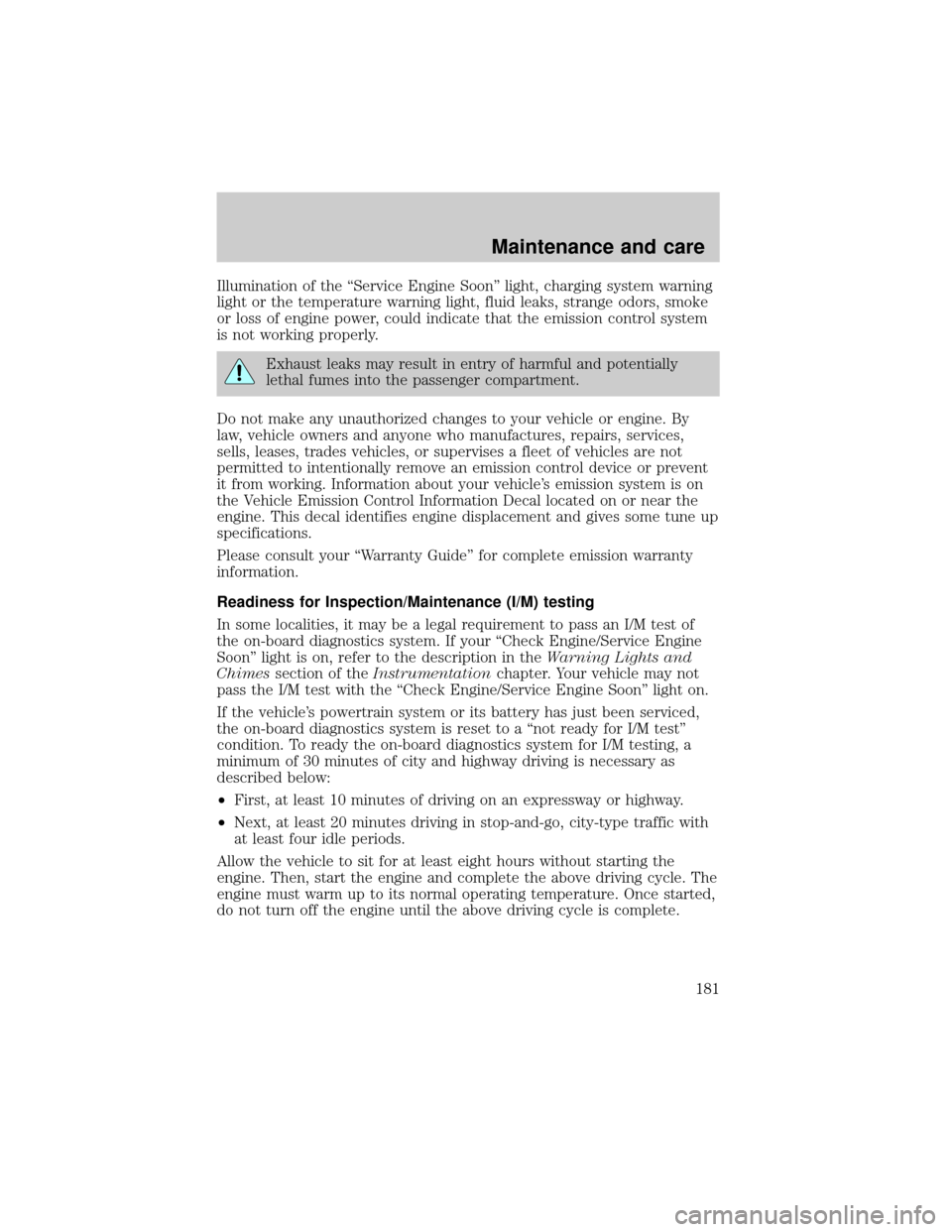
Illumination of the ªService Engine Soonº light, charging system warning
light or the temperature warning light, fluid leaks, strange odors, smoke
or loss of engine power, could indicate that the emission control system
is not working properly.
Exhaust leaks may result in entry of harmful and potentially
lethal fumes into the passenger compartment.
Do not make any unauthorized changes to your vehicle or engine. By
law, vehicle owners and anyone who manufactures, repairs, services,
sells, leases, trades vehicles, or supervises a fleet of vehicles are not
permitted to intentionally remove an emission control device or prevent
it from working. Information about your vehicle's emission system is on
the Vehicle Emission Control Information Decal located on or near the
engine. This decal identifies engine displacement and gives some tune up
specifications.
Please consult your ªWarranty Guideº for complete emission warranty
information.
Readiness for Inspection/Maintenance (I/M) testing
In some localities, it may be a legal requirement to pass an I/M test of
the on-board diagnostics system. If your ªCheck Engine/Service Engine
Soonº light is on, refer to the description in theWarning Lights and
Chimessection of theInstrumentationchapter. Your vehicle may not
pass the I/M test with the ªCheck Engine/Service Engine Soonº light on.
If the vehicle's powertrain system or its battery has just been serviced,
the on-board diagnostics system is reset to a ªnot ready for I/M testº
condition. To ready the on-board diagnostics system for I/M testing, a
minimum of 30 minutes of city and highway driving is necessary as
described below:
²First, at least 10 minutes of driving on an expressway or highway.
²Next, at least 20 minutes driving in stop-and-go, city-type traffic with
at least four idle periods.
Allow the vehicle to sit for at least eight hours without starting the
engine. Then, start the engine and complete the above driving cycle. The
engine must warm up to its normal operating temperature. Once started,
do not turn off the engine until the above driving cycle is complete.
Maintenance and care
181
Page 182 of 224
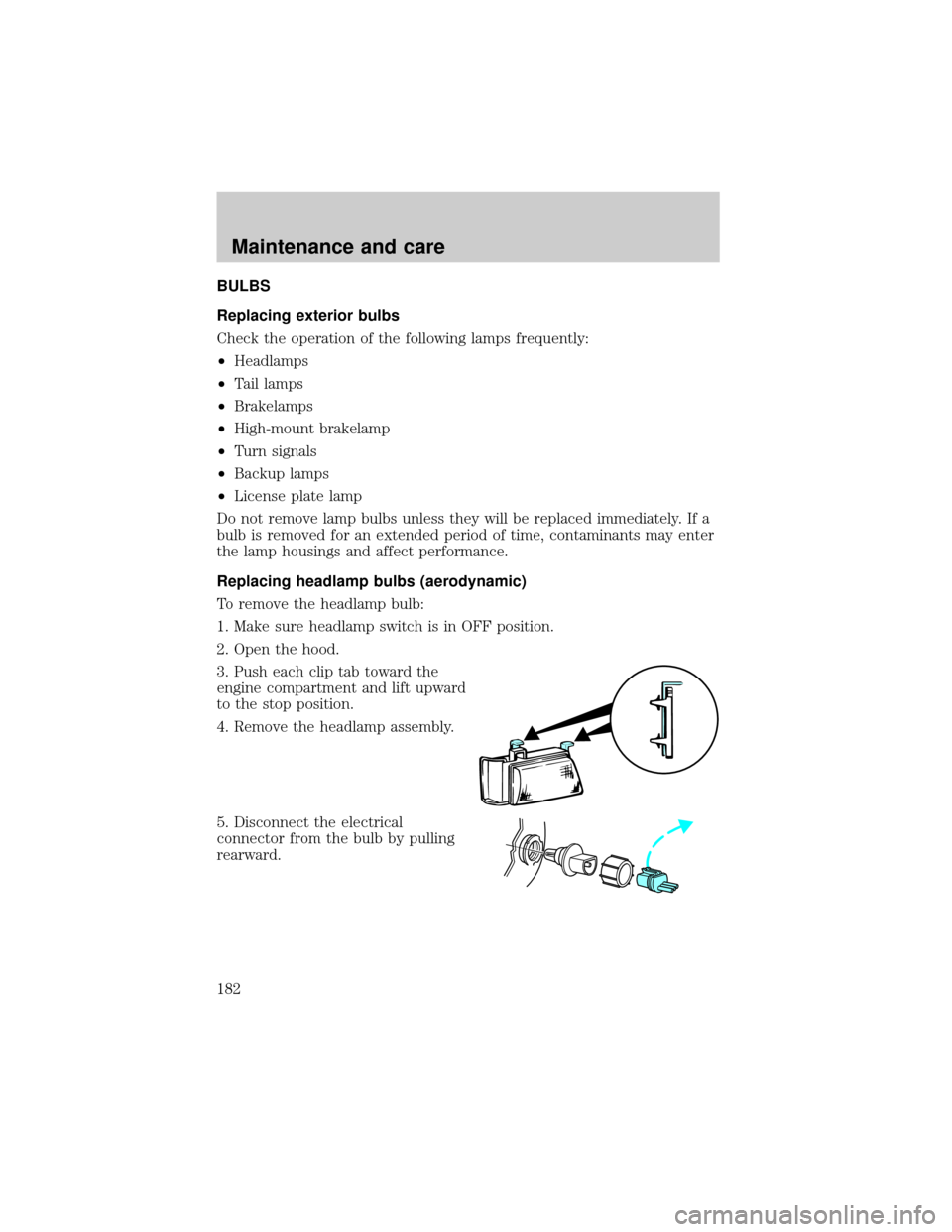
BULBS
Replacing exterior bulbs
Check the operation of the following lamps frequently:
²Headlamps
²Tail lamps
²Brakelamps
²High-mount brakelamp
²Turn signals
²Backup lamps
²License plate lamp
Do not remove lamp bulbs unless they will be replaced immediately. If a
bulb is removed for an extended period of time, contaminants may enter
the lamp housings and affect performance.
Replacing headlamp bulbs (aerodynamic)
To remove the headlamp bulb:
1. Make sure headlamp switch is in OFF position.
2. Open the hood.
3. Push each clip tab toward the
engine compartment and lift upward
to the stop position.
4. Remove the headlamp assembly.
5. Disconnect the electrical
connector from the bulb by pulling
rearward.
Maintenance and care
182
Page 189 of 224
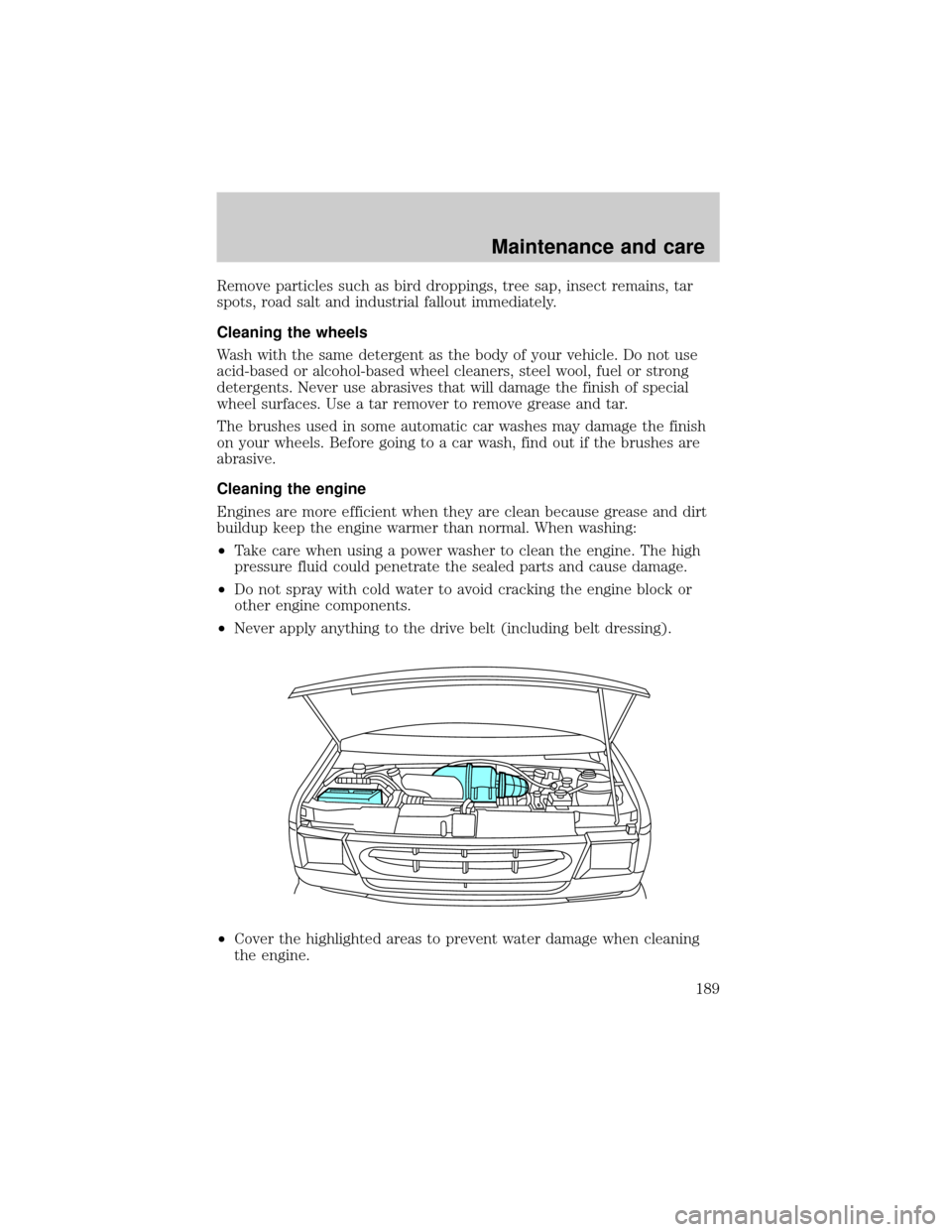
Remove particles such as bird droppings, tree sap, insect remains, tar
spots, road salt and industrial fallout immediately.
Cleaning the wheels
Wash with the same detergent as the body of your vehicle. Do not use
acid-based or alcohol-based wheel cleaners, steel wool, fuel or strong
detergents. Never use abrasives that will damage the finish of special
wheel surfaces. Use a tar remover to remove grease and tar.
The brushes used in some automatic car washes may damage the finish
on your wheels. Before going to a car wash, find out if the brushes are
abrasive.
Cleaning the engine
Engines are more efficient when they are clean because grease and dirt
buildup keep the engine warmer than normal. When washing:
²Take care when using a power washer to clean the engine. The high
pressure fluid could penetrate the sealed parts and cause damage.
²Do not spray with cold water to avoid cracking the engine block or
other engine components.
²Never apply anything to the drive belt (including belt dressing).
²Cover the highlighted areas to prevent water damage when cleaning
the engine.
Maintenance and care
189
Page 190 of 224
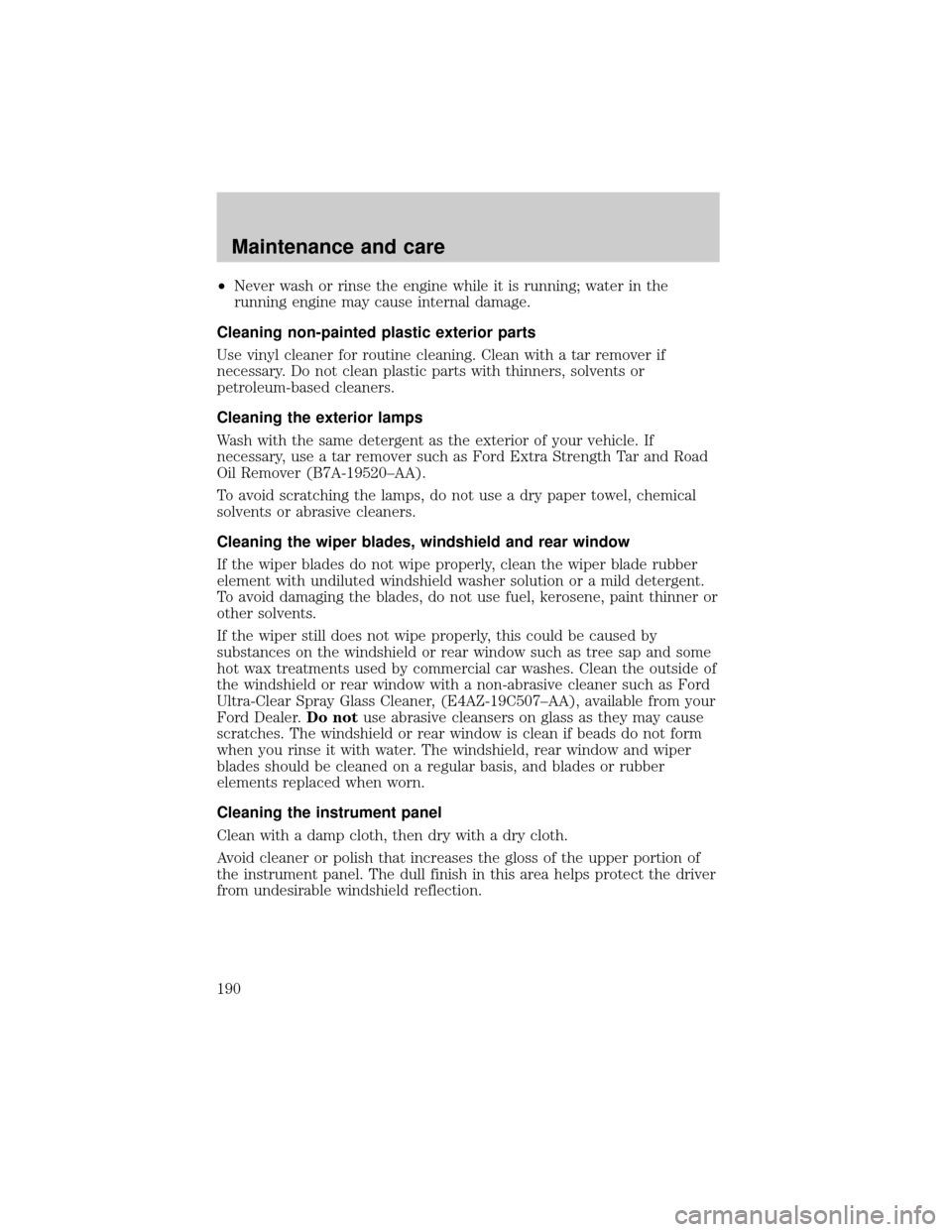
²Never wash or rinse the engine while it is running; water in the
running engine may cause internal damage.
Cleaning non-painted plastic exterior parts
Use vinyl cleaner for routine cleaning. Clean with a tar remover if
necessary. Do not clean plastic parts with thinners, solvents or
petroleum-based cleaners.
Cleaning the exterior lamps
Wash with the same detergent as the exterior of your vehicle. If
necessary, use a tar remover such as Ford Extra Strength Tar and Road
Oil Remover (B7A-19520±AA).
To avoid scratching the lamps, do not use a dry paper towel, chemical
solvents or abrasive cleaners.
Cleaning the wiper blades, windshield and rear window
If the wiper blades do not wipe properly, clean the wiper blade rubber
element with undiluted windshield washer solution or a mild detergent.
To avoid damaging the blades, do not use fuel, kerosene, paint thinner or
other solvents.
If the wiper still does not wipe properly, this could be caused by
substances on the windshield or rear window such as tree sap and some
hot wax treatments used by commercial car washes. Clean the outside of
the windshield or rear window with a non-abrasive cleaner such as Ford
Ultra-Clear Spray Glass Cleaner, (E4AZ-19C507±AA), available from your
Ford Dealer.Do notuse abrasive cleansers on glass as they may cause
scratches. The windshield or rear window is clean if beads do not form
when you rinse it with water. The windshield, rear window and wiper
blades should be cleaned on a regular basis, and blades or rubber
elements replaced when worn.
Cleaning the instrument panel
Clean with a damp cloth, then dry with a dry cloth.
Avoid cleaner or polish that increases the gloss of the upper portion of
the instrument panel. The dull finish in this area helps protect the driver
from undesirable windshield reflection.
Maintenance and care
190
Page 192 of 224
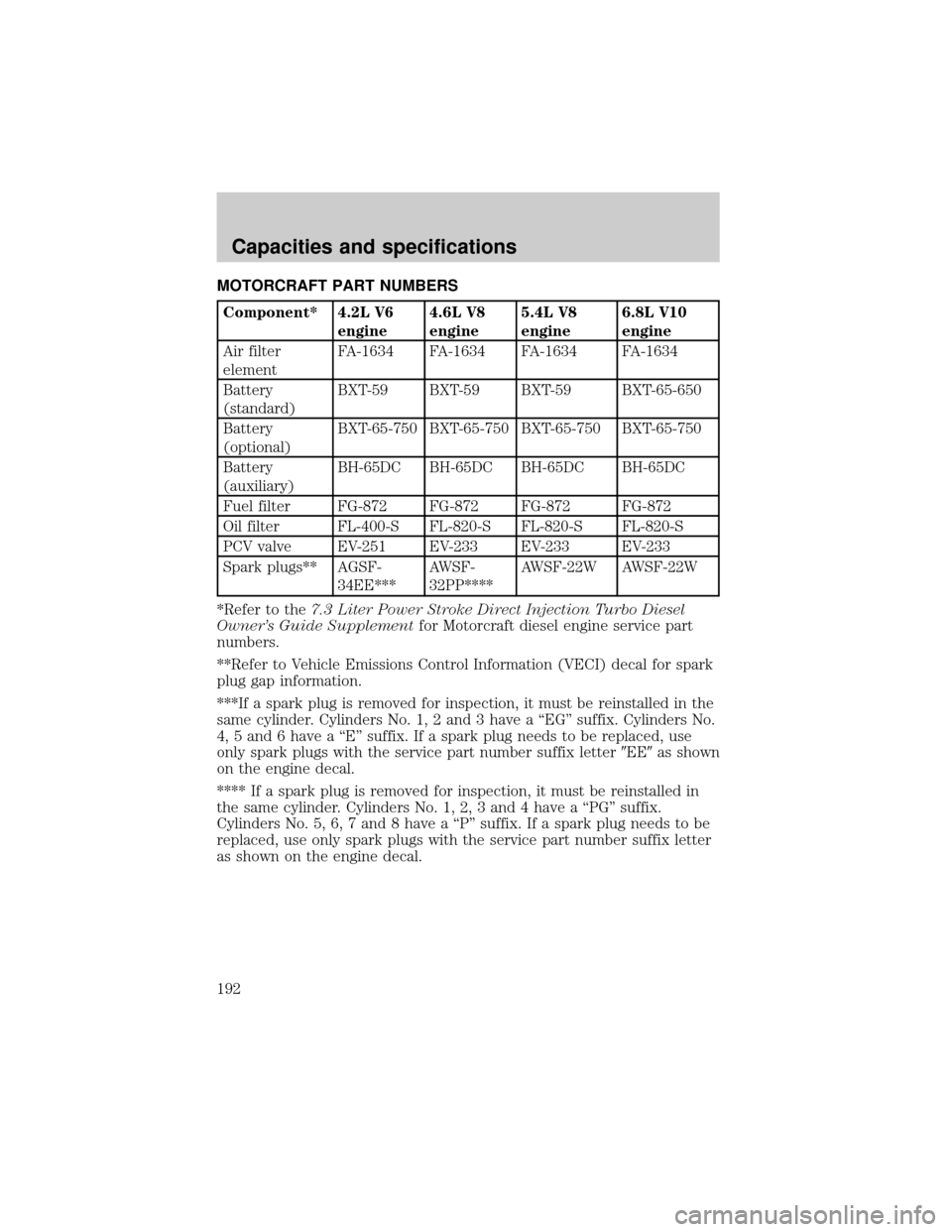
MOTORCRAFT PART NUMBERS
Component* 4.2L V6
engine4.6L V8
engine5.4L V8
engine6.8L V10
engine
Air filter
elementFA-1634 FA-1634 FA-1634 FA-1634
Battery
(standard)BXT-59 BXT-59 BXT-59 BXT-65-650
Battery
(optional)BXT-65-750 BXT-65-750 BXT-65-750 BXT-65-750
Battery
(auxiliary)BH-65DC BH-65DC BH-65DC BH-65DC
Fuel filter FG-872 FG-872 FG-872 FG-872
Oil filter FL-400-S FL-820-S FL-820-S FL-820-S
PCV valve EV-251 EV-233 EV-233 EV-233
Spark plugs** AGSF-
34EE***AWSF-
32PP****AWSF-22W AWSF-22W
*Refer to the7.3 Liter Power Stroke Direct Injection Turbo Diesel
Owner's Guide Supplementfor Motorcraft diesel engine service part
numbers.
**Refer to Vehicle Emissions Control Information (VECI) decal for spark
plug gap information.
***If a spark plug is removed for inspection, it must be reinstalled in the
same cylinder. Cylinders No. 1, 2 and 3 have a ªEGº suffix. Cylinders No.
4, 5 and 6 have a ªEº suffix. If a spark plug needs to be replaced, use
only spark plugs with the service part number suffix letter9EE9as shown
on the engine decal.
**** If a spark plug is removed for inspection, it must be reinstalled in
the same cylinder. Cylinders No. 1, 2, 3 and 4 have a ªPGº suffix.
Cylinders No. 5, 6, 7 and 8 have a ªPº suffix. If a spark plug needs to be
replaced, use only spark plugs with the service part number suffix letter
as shown on the engine decal.
Capacities and specifications
192
Page 193 of 224
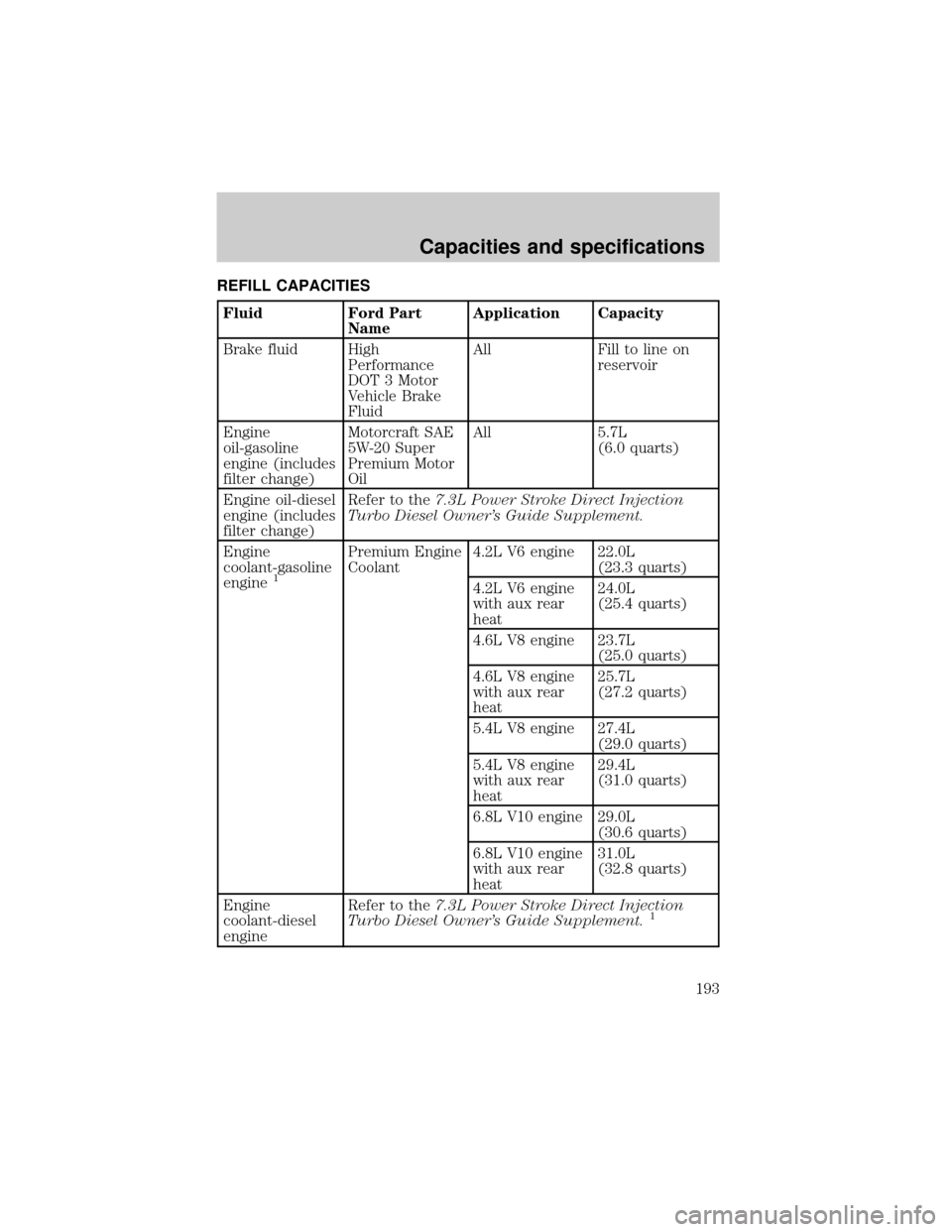
REFILL CAPACITIES
Fluid Ford Part
NameApplication Capacity
Brake fluid High
Performance
DOT 3 Motor
Vehicle Brake
FluidAll Fill to line on
reservoir
Engine
oil-gasoline
engine (includes
filter change)Motorcraft SAE
5W-20 Super
Premium Motor
OilAll 5.7L
(6.0 quarts)
Engine oil-diesel
engine (includes
filter change)Refer to the7.3L Power Stroke Direct Injection
Turbo Diesel Owner's Guide Supplement.
Engine
coolant-gasoline
engine
1
Premium Engine
Coolant4.2L V6 engine 22.0L
(23.3 quarts)
4.2L V6 engine
with aux rear
heat24.0L
(25.4 quarts)
4.6L V8 engine 23.7L
(25.0 quarts)
4.6L V8 engine
with aux rear
heat25.7L
(27.2 quarts)
5.4L V8 engine 27.4L
(29.0 quarts)
5.4L V8 engine
with aux rear
heat29.4L
(31.0 quarts)
6.8L V10 engine 29.0L
(30.6 quarts)
6.8L V10 engine
with aux rear
heat31.0L
(32.8 quarts)
Engine
coolant-diesel
engineRefer to the7.3L Power Stroke Direct Injection
Turbo Diesel Owner's Guide Supplement.
1
Capacities and specifications
193
Page 195 of 224
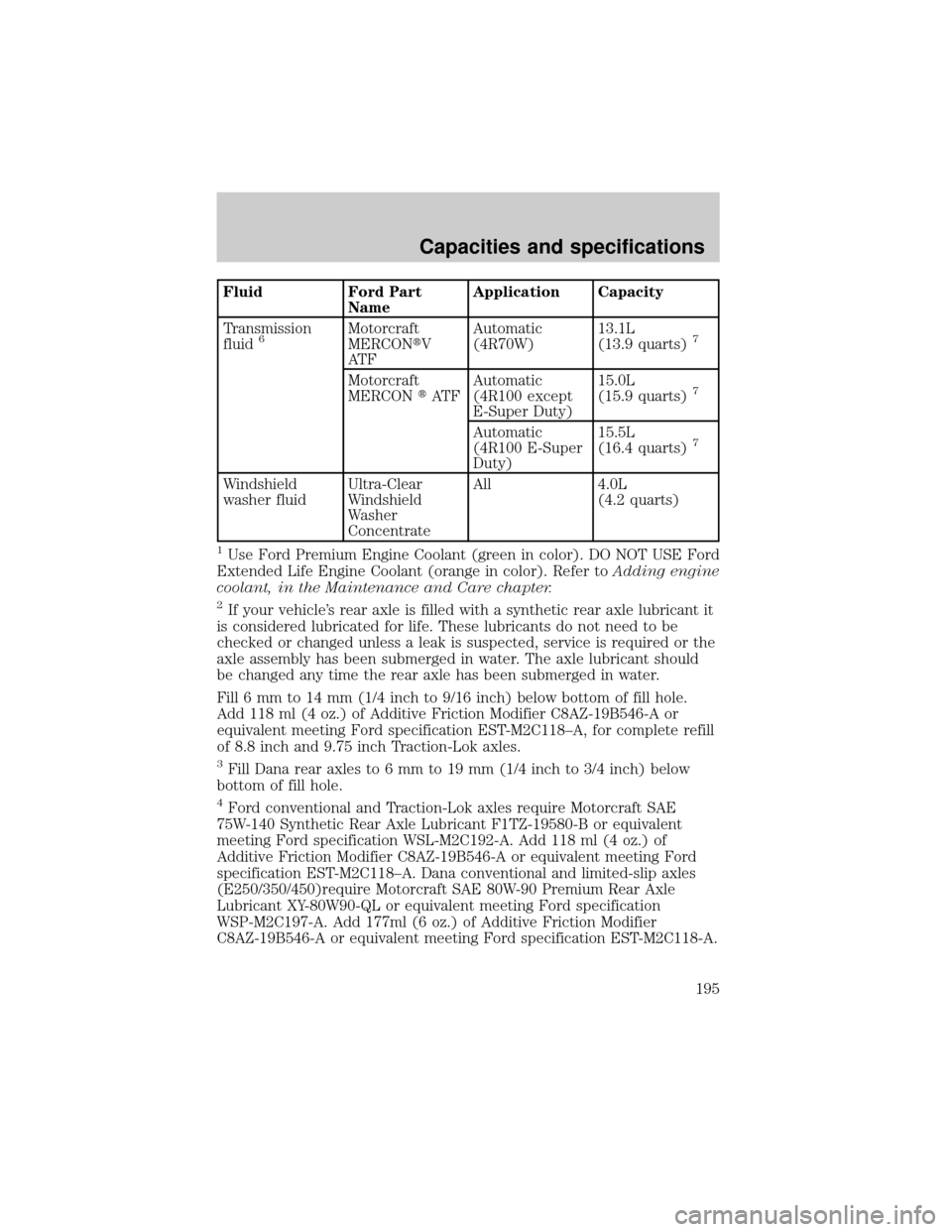
Fluid Ford Part
NameApplication Capacity
Transmission
fluid
6Motorcraft
MERCONtV
AT FAutomatic
(4R70W)13.1L
(13.9 quarts)7
Motorcraft
MERCONtAT FAutomatic
(4R100 except
E-Super Duty)15.0L
(15.9 quarts)7
Automatic
(4R100 E-Super
Duty)15.5L
(16.4 quarts)7
Windshield
washer fluidUltra-Clear
Windshield
Washer
ConcentrateAll 4.0L
(4.2 quarts)
1Use Ford Premium Engine Coolant (green in color). DO NOT USE Ford
Extended Life Engine Coolant (orange in color). Refer toAdding engine
coolant, in the Maintenance and Care chapter.
2If your vehicle's rear axle is filled with a synthetic rear axle lubricant it
is considered lubricated for life. These lubricants do not need to be
checked or changed unless a leak is suspected, service is required or the
axle assembly has been submerged in water. The axle lubricant should
be changed any time the rear axle has been submerged in water.
Fill 6 mm to 14 mm (1/4 inch to 9/16 inch) below bottom of fill hole.
Add 118 ml (4 oz.) of Additive Friction Modifier C8AZ-19B546-A or
equivalent meeting Ford specification EST-M2C118±A, for complete refill
of 8.8 inch and 9.75 inch Traction-Lok axles.
3Fill Dana rear axles to 6 mm to 19 mm (1/4 inch to 3/4 inch) below
bottom of fill hole.
4Ford conventional and Traction-Lok axles require Motorcraft SAE
75W-140 Synthetic Rear Axle Lubricant F1TZ-19580-B or equivalent
meeting Ford specification WSL-M2C192-A. Add 118 ml (4 oz.) of
Additive Friction Modifier C8AZ-19B546-A or equivalent meeting Ford
specification EST-M2C118±A. Dana conventional and limited-slip axles
(E250/350/450)require Motorcraft SAE 80W-90 Premium Rear Axle
Lubricant XY-80W90-QL or equivalent meeting Ford specification
WSP-M2C197-A. Add 177ml (6 oz.) of Additive Friction Modifier
C8AZ-19B546-A or equivalent meeting Ford specification EST-M2C118-A.
Capacities and specifications
195
Page 196 of 224
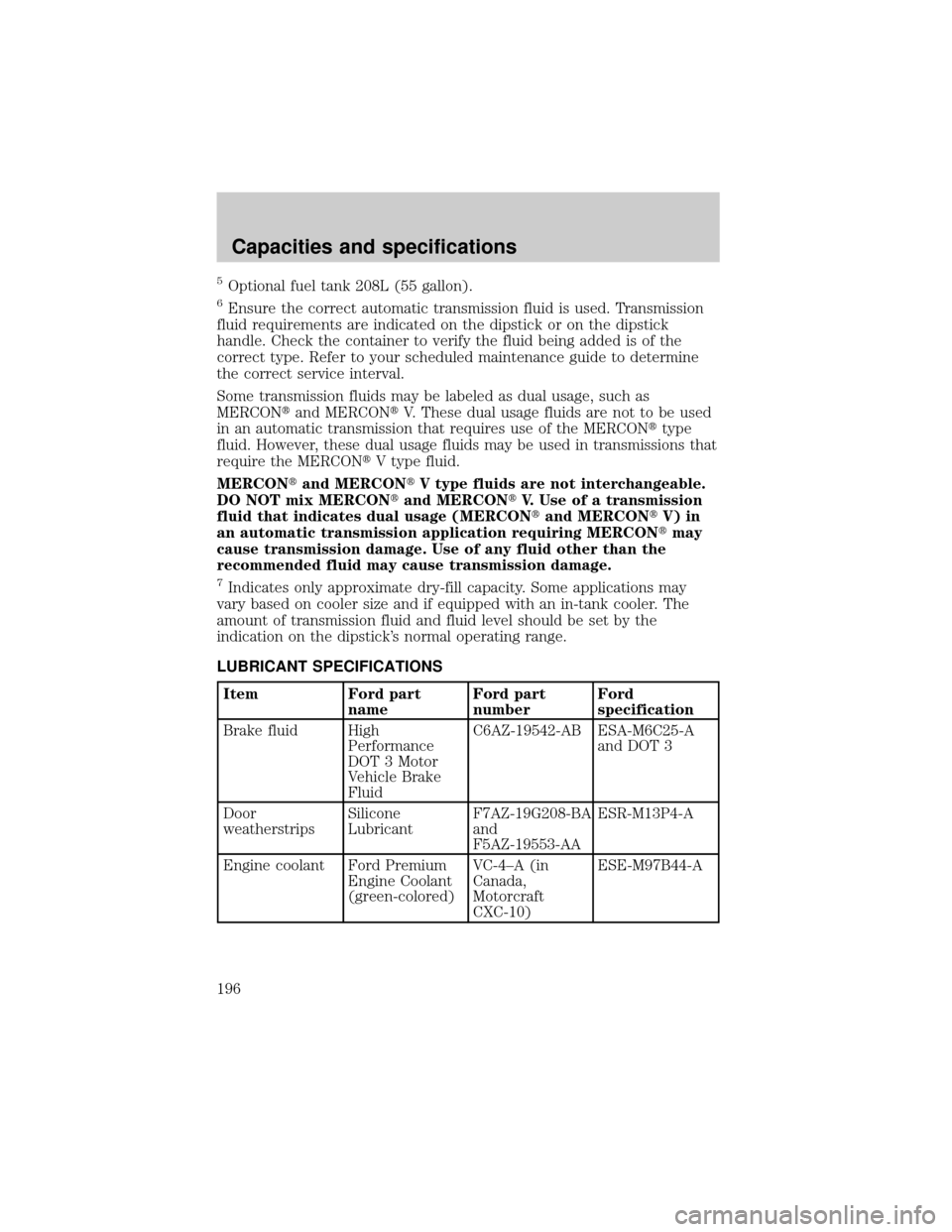
5Optional fuel tank 208L (55 gallon).
6Ensure the correct automatic transmission fluid is used. Transmission
fluid requirements are indicated on the dipstick or on the dipstick
handle. Check the container to verify the fluid being added is of the
correct type. Refer to your scheduled maintenance guide to determine
the correct service interval.
Some transmission fluids may be labeled as dual usage, such as
MERCONtand MERCONtV. These dual usage fluids are not to be used
in an automatic transmission that requires use of the MERCONttype
fluid. However, these dual usage fluids may be used in transmissions that
require the MERCONtV type fluid.
MERCONtand MERCONtV type fluids are not interchangeable.
DO NOT mix MERCONtand MERCONtV. Use of a transmission
fluid that indicates dual usage (MERCONtand MERCONtV) in
an automatic transmission application requiring MERCONtmay
cause transmission damage. Use of any fluid other than the
recommended fluid may cause transmission damage.
7Indicates only approximate dry-fill capacity. Some applications may
vary based on cooler size and if equipped with an in-tank cooler. The
amount of transmission fluid and fluid level should be set by the
indication on the dipstick's normal operating range.
LUBRICANT SPECIFICATIONS
Item Ford part
nameFord part
numberFord
specification
Brake fluid High
Performance
DOT 3 Motor
Vehicle Brake
FluidC6AZ-19542-AB ESA-M6C25-A
and DOT 3
Door
weatherstripsSilicone
LubricantF7AZ-19G208-BA
and
F5AZ-19553-AAESR-M13P4-A
Engine coolant Ford Premium
Engine Coolant
(green-colored)VC-4±A (in
Canada,
Motorcraft
CXC-10)ESE-M97B44-A
Capacities and specifications
196
Page 197 of 224
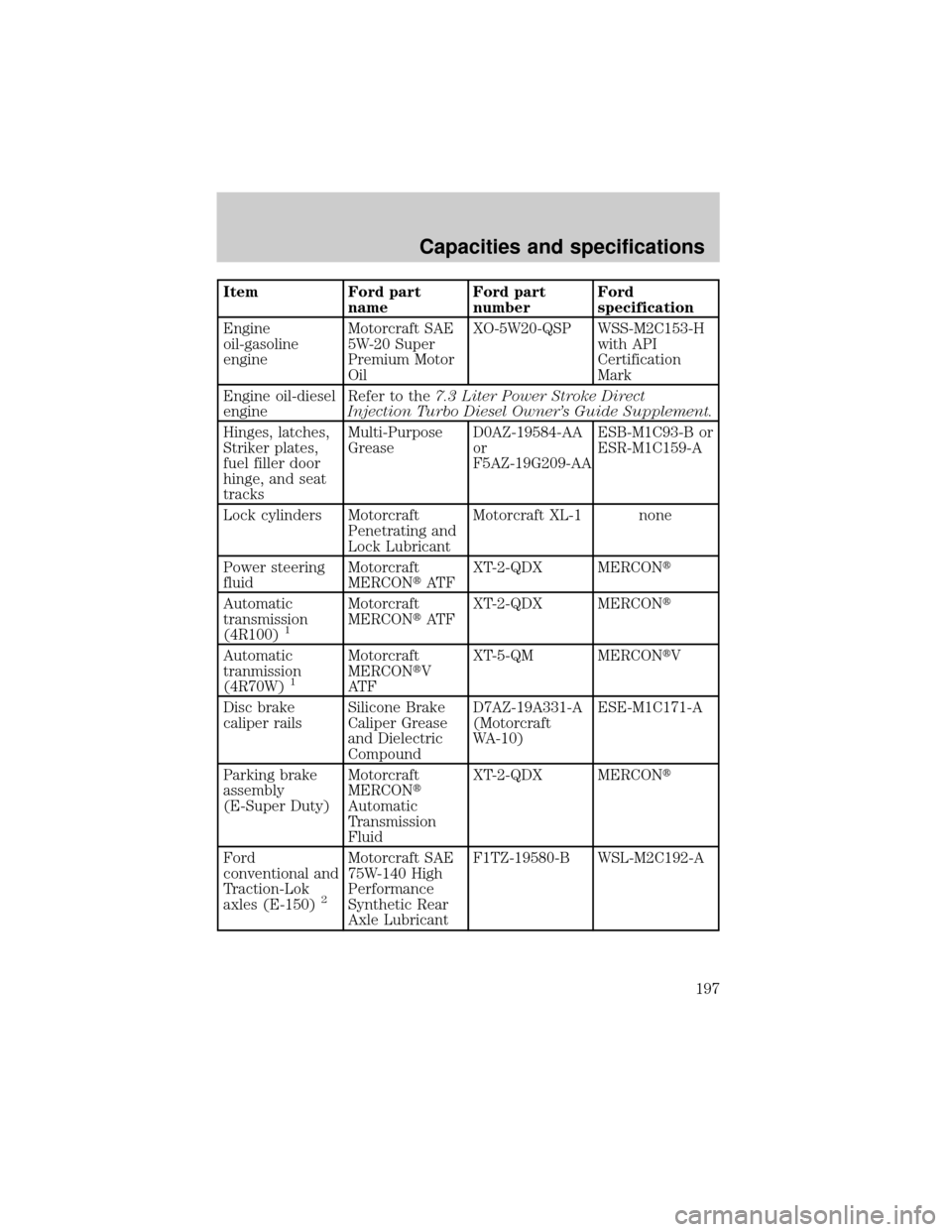
Item Ford part
nameFord part
numberFord
specification
Engine
oil-gasoline
engineMotorcraft SAE
5W-20 Super
Premium Motor
OilXO-5W20-QSP WSS-M2C153-H
with API
Certification
Mark
Engine oil-diesel
engineRefer to the7.3 Liter Power Stroke Direct
Injection Turbo Diesel Owner's Guide Supplement.
Hinges, latches,
Striker plates,
fuel filler door
hinge, and seat
tracksMulti-Purpose
GreaseD0AZ-19584-AA
or
F5AZ-19G209-AAESB-M1C93-B or
ESR-M1C159-A
Lock cylinders Motorcraft
Penetrating and
Lock LubricantMotorcraft XL-1 none
Power steering
fluidMotorcraft
MERCONtAT FXT-2-QDX MERCONt
Automatic
transmission
(4R100)
1
Motorcraft
MERCONtAT FXT-2-QDX MERCONt
Automatic
tranmission
(4R70W)
1
Motorcraft
MERCONtV
AT FXT-5-QM MERCONtV
Disc brake
caliper railsSilicone Brake
Caliper Grease
and Dielectric
CompoundD7AZ-19A331-A
(Motorcraft
WA-10)ESE-M1C171-A
Parking brake
assembly
(E-Super Duty)Motorcraft
MERCONt
Automatic
Transmission
FluidXT-2-QDX MERCONt
Ford
conventional and
Traction-Lok
axles (E-150)
2
Motorcraft SAE
75W-140 High
Performance
Synthetic Rear
Axle LubricantF1TZ-19580-B WSL-M2C192-A
Capacities and specifications
197
Page 199 of 224
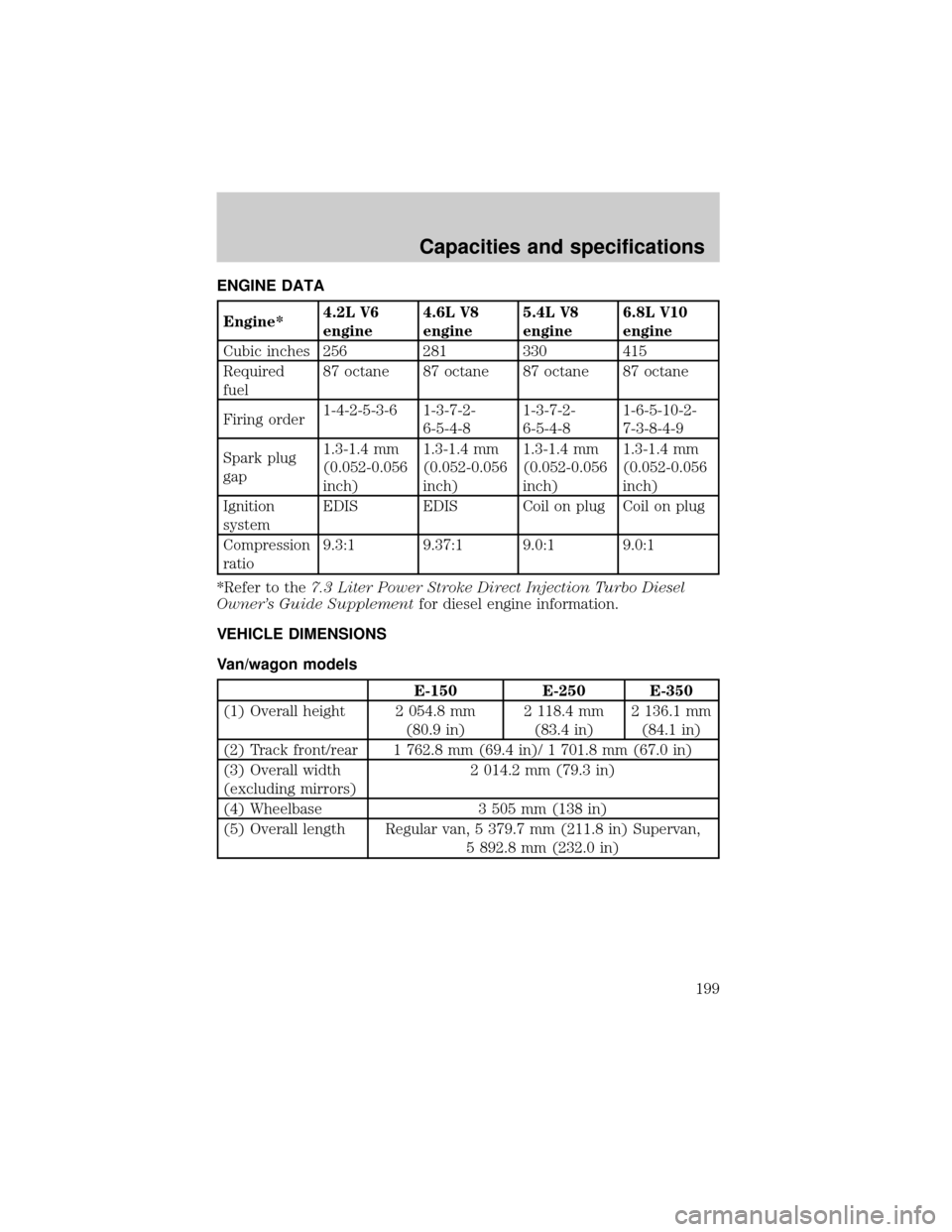
ENGINE DATA
Engine*4.2L V6
engine4.6L V8
engine5.4L V8
engine6.8L V10
engine
Cubic inches 256 281 330 415
Required
fuel87 octane 87 octane 87 octane 87 octane
Firing order1-4-2-5-3-6 1-3-7-2-
6-5-4-81-3-7-2-
6-5-4-81-6-5-10-2-
7-3-8-4-9
Spark plug
gap1.3-1.4 mm
(0.052-0.056
inch)1.3-1.4 mm
(0.052-0.056
inch)1.3-1.4 mm
(0.052-0.056
inch)1.3-1.4 mm
(0.052-0.056
inch)
Ignition
systemEDIS EDIS Coil on plug Coil on plug
Compression
ratio9.3:1 9.37:1 9.0:1 9.0:1
*Refer to the7.3 Liter Power Stroke Direct Injection Turbo Diesel
Owner's Guide Supplementfor diesel engine information.
VEHICLE DIMENSIONS
Van/wagon models
E-150 E-250 E-350
(1) Overall height 2 054.8 mm
(80.9 in)2 118.4 mm
(83.4 in)2 136.1 mm
(84.1 in)
(2) Track front/rear 1 762.8 mm (69.4 in)/ 1 701.8 mm (67.0 in)
(3) Overall width
(excluding mirrors)2 014.2 mm (79.3 in)
(4) Wheelbase 3 505 mm (138 in)
(5) Overall length Regular van, 5 379.7 mm (211.8 in) Supervan,
5 892.8 mm (232.0 in)
Capacities and specifications
199